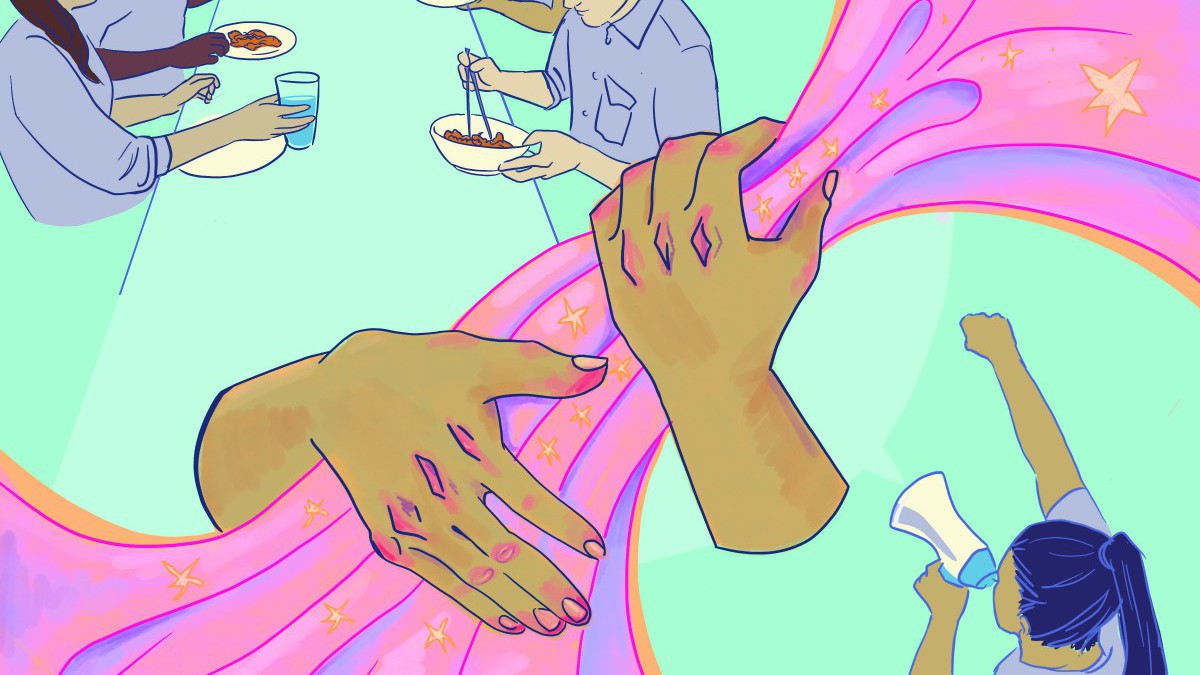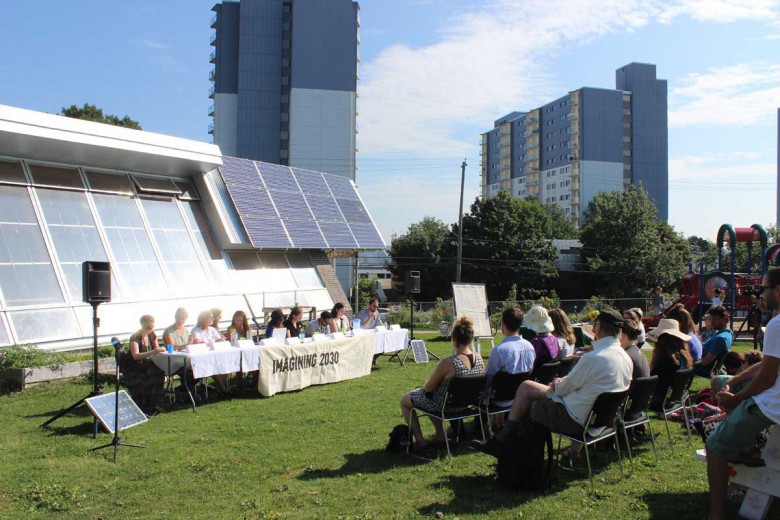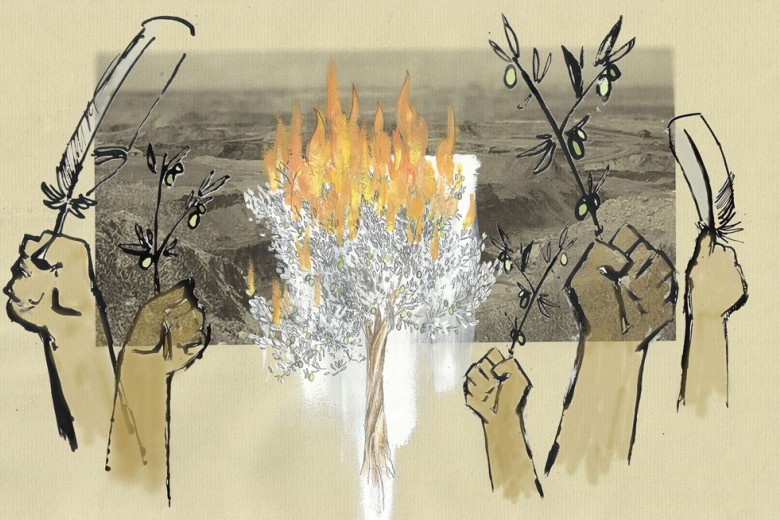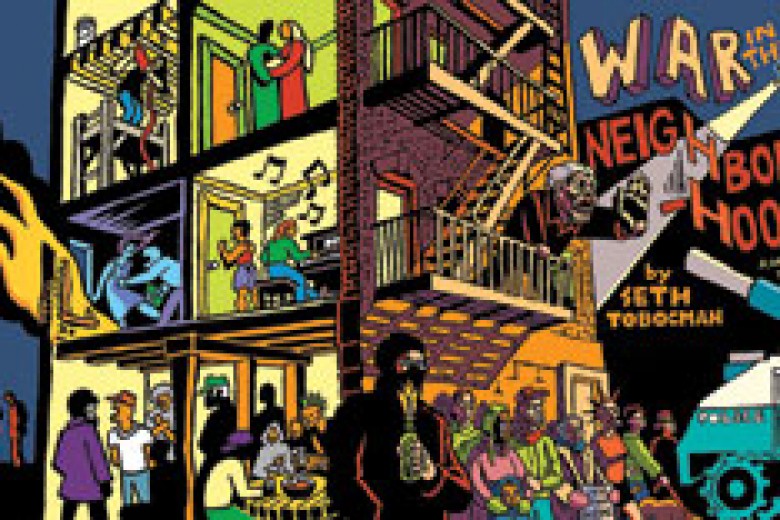If you roll your eyes when you hear “self-care,” you’re not alone. The term conjures imagery of flickering scented candles, giant bathtubs overflowing with bubbles, hefty glasses of wine, minimalist home decor, and even vibrators under the banner of “wellness.”
Many conceptualizations of self-care over-emphasize the “self” and decontextualize the “care.” This highly individualized version of self-care prescribes a person to perform a checklist of happiness-maximizing activities in isolation from their community.
The self-care industrial complex has become a trillion-dollar industry that tells us we can escape the stresses of the unjust and violent systems we inhabit, as long as we can afford the monthly subscription. For activists invested in building collective momentum, this commodified self-care is easy to write off as a distraction.
We – Sarah Mohammed and Jorden Cummings – see self-care differently. When done properly, thoughtfully, and carefully, self-care is a tool to maintain momentum, one that all activists should add to their toolbox.
This idea formed for both of us in slightly different ways. Mohammed had accepted that being well in an unwell society is impossible. She was interested in making society well, not herself. For Mohammed, activism was like lighting a series of matches- ever so often, a passionate flame would burn until nothing was left but ash. This experience seemed to echo among activists around her. Cummings’ interest stemmed from experience in academic systems that purposefully weaponize and foster worker overload and burnout to suppress the potential effectiveness of labour activism. Trying to survive as an academic with chronic illnesses in a system that champions burnout as a point of pride, they realized how overwork was used to oppress voices demanding this system change.
We both started to reconsider our approaches to activism when we saw how this compulsive, relentless cycle of action and burnout can viciously undermine any momentum of collective action. We came together to research how Saskatoon-based activists build care practices.
Black and Latinx activists have advocated for radical self-care since the 1960s. Radical self-care resists capitalist modes of hyper-productivity and labour alienation by proposing care work that is process-focused and serves the people who produce it. But how do activists meet their wellness needs in an age where self-care has become a commodity? Does radical self-care still apply? Based on our work, the answer is yes, absolutely!
They felt helpless when faced with slow progress toward policy change, low turnout at events, and leftist in-fighting that seemed to consume all efforts toward tangible change. As one participant, Ramona shared, “Something had to give.”
Self-care as resistance
For our study, Mohammed interviewed seven Saskatoon-based activists, all people of colour (Black, South Asian, Indigenous Latina, and Brown), engaged in organizing around decolonial feminist work, environmental sustainability, and anti-racism. Through organizing, activists put their values into practice to build a better future. They crafted space for people to connect over issues that affected them and created distribution networks for resources such as fresh produce, transportation, childcare, employment assistance, and educational resources while protecting their spaces from right-wing antagonists. These activists were connected to activist communities who “gave [them] a healing space,” in the words of one.
But even activists with strong community connections burn out. The ones Mohammed spoke to were exposed to a heavy weight of suffering, frustration with global events, and stress accumulated into exhaustion. They felt helpless when faced with slow progress toward policy change, low turnout at events, and leftist in-fighting that seemed to consume all efforts toward tangible change. As one participant, Ramona shared, “Something had to give.”
For many, what gave was their involvement in activist work. When they couldn’t push through any more exhaustion, they withdrew completely. This understandable self-preservation is something bell hooks described as self-segregating: “remov[ing] oneself from any circumstance where there is danger of violation.” When the activists recovered enough to re-engage, they resumed.
After talking with these activists, it became clear that this care is critical and is, itself, resistance work.
Challenging internalized capitalism
Despite our best efforts, activists are always susceptible to reproducing capitalist values in our everyday practices. Many of the activists interviewed described facing hard truths about these contradictions in their attitudes, assumptions, and behaviours toward activism and self-care. For example, some realized they were applying capitalist notions of productivity and competition to their activism, striving for high numbers of deliverables and growing frustrated with peers who they perceived as not dedicating enough time to causes.
Slowly, they realized that when you are part of a resistance movement, caring for yourself and receiving care from others are part of nurturing that movement.
Others approached activism as a service to others from which they had nothing to gain. Although willing to extend care to others, they had a hard time accepting care in return. An activist going by the pseudonym CoolGuy2022 realized that while there was reciprocity between himself and his community, his attitudes toward himself did not reflect that equality. “You can be taking care of everyone and never, ever take care of yourself,” he said. When their work was oriented toward charitably uplifting those less fortunate, they saw it as benefiting others with disparate interests. However, when activists came from a place of solidarity, they saw their interests as intermingled. As Ramona observed “look at how we’re thriving, look at how we’re resisting. Yeah, look at the good that we’re doing within our communities, for ourselves.”
Slowly, they realized that when you are part of a resistance movement, caring for yourself and receiving care from others are part of nurturing that movement. As Audre Lorde famously put it, taking care of ourselves is an “act of political warfare” that still has a place in activist communities today.
The activists in our project described restorative self-care as centred on substantiating their values of justice, equity, sustainability, and anti-colonialism. With this foundation, activists developed self-care as praxis. More specifically, the restorative self-care described by Saskatoon activists participating in our study involved five practices.
Slow Down and Ground Yourself
The activists we spoke to found that processing their experiences helped them foster a sense of agency amid distress, combatting exhaustion and burnout. They described how carving out time for art, mindfulness, and other expressive, creative practices such as journalling, poetry, blogging, painting, and photography helped to ground them.
Those who were newcomers to Saskatoon additionally found that grounding helped them feel less out of place. Importantly, grounding did not erase their feelings of isolation, anger, and distress, but created space for these feelings to be appreciated as reasonable reactions to oppression. In a context where happiness is an ideal that necessitates conforming to oppressive systems, holding space for unhappiness became a form of resistance.
Asserting Agency
The activists Mohammed interviewed increased their sense of agency by adopting intentionality around their time. They did this through establishing clear boundaries around activism expectations, like clearly defining who will do what and recognizing that they don’t have to be present for every meeting and action. For our participants, this included making thoughtful decisions about distributing their energy and prioritizing their most fulfilling interests. Faced with invitations from multiple activist organizations, Rebecca was selective about her participation, saying “you have to pick and choose what you want to be part of.”
Reconnecting with Your Body
When overwhelmed, it can be easy to disconnect from embodied experiences and numb out physically. Activists described the physical toll that stress took on them and the difficulties they had calming their bodies. Our participants described both high-intensity, physically demanding choices (e.g., kickboxing, running, and strength exercising) as an outlet for intense emotions, and lower-intensity choices (e.g., walking, yoga, and receiving massage) to encourage relaxation and being present. These relaxation strategies counteracted the sense of perpetual crisis and, as Camilla phrased it, “fighting all the time.” CoolGuy2022, as well, found his mental and physical health were interconnected, saying “I’m not sure that I know so many ways of relaxing my mind without engaging my body.”
Generating Joy
Moreover, placing joy as central to well-being and seeing it as a tool for movement building is critical.
Our interviewed activists described joy as an antidote to immobilization and hopelessness. They worked to generate joyful experiences such as celebrating accomplishments and milestones with community, making space in their organizations to recognize hope, or nurturing their passions through private and social activities. These were not band-aids to soothe stress, but consistent practices to prevent despair. The practices began from a place of pleasure, as Camilla states she started just “because it made me feel good”
Moreover, placing joy as central to well-being and seeing it as a tool for movement building is critical. As adrienne maree brown notes in Pleasure Activism, “In touch with the erotic, I become less willing to accept powerlessness, or those other supplied states of being which are not native to me, such as resignation, despair, self-effacement, depression, self-denial.” To seek joy, pleasure, care, calm, and contentment in the face of a world that needs activists also to fight is a critical act of resistance in and of itself.
Tolerating Discomfort
Respecting activist values often means going against the grain, which can lead to uncomfortable social situations that contribute to burnout. Racialized activists in our project recognized they also embodied an Otherness that was not always welcome. By learning to stay present with these feelings of discomfort rather than turning away from them, activists prioritized themselves, their values, and made space to validate these emotions. Referring to occupying spaces that weren’t created with people of colour in mind, Ramona said “I can see the discomfort in people's faces. I have realized that I don't always have to carry that mental load. Just my being there, my existence in that space itself is resistance.”
Sustaining our movements
Notably, all of these practices are accessible. While we acknowledge that spending money might facilitate some of these practices (e.g., engaging a therapist to do personal work on boundary setting or obtaining services related to bodily connection, like massage or gym access), money is not required to access them. Activists forming caring community connections can facilitate these practices together for the collective benefit. We can witness one another’s discomfort, ground ourselves in company, and learn to set and respect boundaries together. We can value and prioritize collective wellness, respecting it as a core, non-negotiable ingredient to the success of any movement. Actions that openly value the well-being of those who contribute to them – rather than seeing self-care as an act of consumption that detracts from our work – will inevitably prioritize people and relationships to create more sustainable organizing so that we can move forward steadily rather than in stops and starts as activists burn out, withdraw, and re-engage.
Withdrawing from labour for your wellness makes sense when your labour profits a few people you’ve never met. But when your labour tangibly improves the lives of your community and you can see the direct impact of your work, taking a break means withdrawing from that “healing space.”
Activist work is never-ending. Critical roles are always in need of filling, particularly as the non-profit industrial complex works to undermine the effectiveness of social services that neoliberal capitalism has made necessary. Many activists sacrifice self-care and personal wellness, asking themselves, how can we possibly take care of ourselves when there is resistance work to be done?
Taking time off from organizing is not the same as taking time off of work. Withdrawing from labour for your wellness makes sense when your labour profits a few people you’ve never met. But when your labour tangibly improves the lives of your community and you can see the direct impact of your work, taking a break means withdrawing from that “healing space.”
As Shashi told Mohammed, “To me, practicing care means prioritizing yourself for at least a period of time to make sure that you are in a good space to be able to help others. Like in airplanes, they say you need to put the oxygen [mask] on yourself first before you can take care [of] a child next to you. And I feel like to me, that's what self-care is.”
At its core, resistance is about people and relationships. If the people are not well, the movement cannot be well.
*This article draws on privacy protected interviews from the authors’ research project. As a result Ramona, CoolGuy2022, Rebecca, Camilla, and Shashi are all pseudonyms.




_780_520_90_s_c1.jpg)


